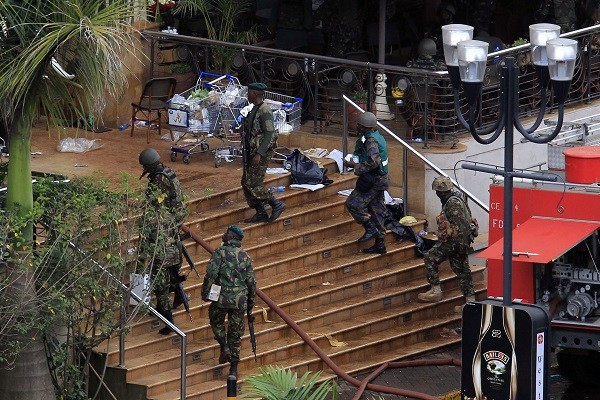The Nairobi Westgate Mall Siege: What Have We Learned?
Africa terrorism expert James Hall examines the causes, context and consequences of the event which captured the world's attention

Why did the terrorists launch such a vicious attack?
The terrorists knew it was highly improbable that the Kenyan army would cave in to their demands and withdraw Kenyan troops from Somalia. And they weren't trying to earn international goodwill, the sort of support necessary to achieve their objective of capturing Somalia and turning it into an Islamic feudal state. If they'd wanted goodwill, why kill Africa's preeminent contemporary poet, Ghana's Kofi Awoonor? Why shoot dead the nephew of Kenya's president Uhuru Kenyatta?
In fact the terrorists simply wanted to remind the world that a decimated al-Shabaab still existed. The mall terror was a demonstration, a lashing out after the group's purging from Somalia by multi-national forces.
Why did they choose the Nairobi Westgate centre?
Any nation that seeks an end to international terrorism, which is most nations if they are sincere about the United Nations (UN) treaties and other accords they have signed, might have been targeted by al-Shabaab. But Kenya was handiest. Kenya's army is al-Shabaab's nemesis. Unable to defeat Kenyan troops on the battlefield, al-Shabaab punished the country at a commercial/entertainment centre.
Hollywood fright-meisters have long known the impact of horror is heightened when placed in environments of everyday life, of innocence. Al-Shabaab seemed to know that their attack on an international group would be less impactful in a setting less homogenised, less Disney-esque, than a 21<sup>st century shopping mall. An attack on a single KFC would not be as impactful, not when a multitude of such eateries existed and hundreds more targets available within an immediately recognisable setting.
Why did the siege capture the world's attention?
The slaughter of innocents in Kenya and elsewhere for political reasons is not new, but what focused world attention was the environment and victims. The Westgate Mall might have been 'upscale' for Nairobi, but it was a strictly middle-class environment for the watching Western, Asian, South African and Oceanic nations.
The uniformity of design, the sameness of décor (highly-reflective surfaces just shy of being garish, appliqué of marble and brass to suggest tradition in a non-traditional environment, the colours of the food court forcing a sense of gaiety) make today's shopping malls as standardised internationally as a bottle of Coca-Cola or a McDonald's sandwich.
Stepping into the Westgate Mall, the customer could just as easily be walking into an identical shopping emporium in Europe, the Americas or Asia's larger cities. The number of foreigners at the Westgate Mall testified to the appeal that familiar surroundings had for them.
One photo from the scene showed a dead woman beneath a sign promoting a Halloween party, celebrating a favourite American holiday not known in Kenya. One of the gunmen gave Mars bars to two children. Although he was unaware that these were the same chocolate snacks given to American children on Halloween, the subliminal connection would not be lost to an American viewer.
Where could al-Shabaab strike next?
Al-Shabaab exists in several pockets throughout the region, including a presence in Tanzania. To mount an attack on a Dar-es-Salaam facility, frequented by foreigners like the Westgate mall, would be possible for al-Shabaab. Somalia might also be a target - given that the government of Somalia is a greater threat to al-Shabaab than Kenya, why not mount an attack on a market in Mogadishu?
The drawback for al-Shabaab in terms of international impact is that such attacks are not uncommon. Depending on the number of casualties, such an attack would be given coverage on international news outlets only in proportion to the body count. The Kenyan mall possessed two characteristics that attracted the attention of the West: Western customers and a Western environment. It would be hard to find another site like this.
Has al-Shabaab gained from the siege?
The mall siege definitely put al-Shabaab on the map - the majority of the world that had not previously heard of al-Shabaab, but they have now. The publicity garnered through the seige will most likely appeal to regional jihadists, who can see the planning and execution capabilities of al-Shabaab. Foreign nationals visiting Africa are certainly likely to be more vigilant in the wake of the attack.
But the wider world would not be terrified. Al-Shabaab is a local group with, at most, regional reach. Further, urban terrorism has become commonplace in the West. Bombings of public gatherings, shooting-ups of schools and military facilities, and numerous other incidents are being staged by "nobodies," some with no ideological platform, but all apparently motivated by rage and confusion. While terrorist acts remain terrifying, the terrorist himself has become banal.
In fact the Westgate Mall attack ensured that al-Shabaab exponentially gained more enemies than fanatical converts. For a group of fundamentalists fervently fixed upon the past, they certainly cannot read history. Africans despised al-Qaeda for killing hundreds of their continent's people and injuring thousands more in the East African US Embassy Bombings in 1998.The Westgate siege has had a similar impact.
Although al-Shabaab is celebrating its new status as al-Qaeda's most-dangerous affiliate, the mall massacre was a pyrrhic victory. The pride has been established, but now the fall awaits.
James Hall is founding editor of the Africa Conflict Monthly Monitor, which is published by Consultancy Africa and offers analysis of all major conflict and terrorism trends on the continent.
If you wish to find out more about ACMM, or subscribe, click on the following link.
© Copyright IBTimes 2025. All rights reserved.





















